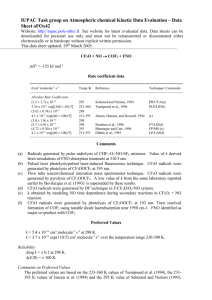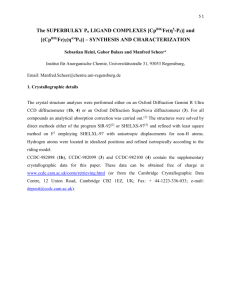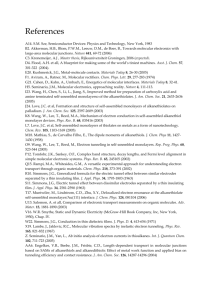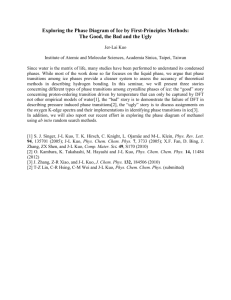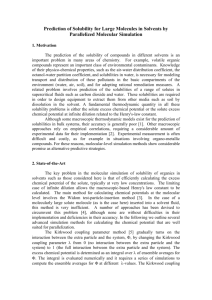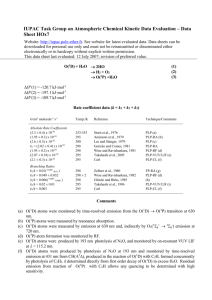QM/MM MD simulation - Royal Society of Chemistry
advertisement
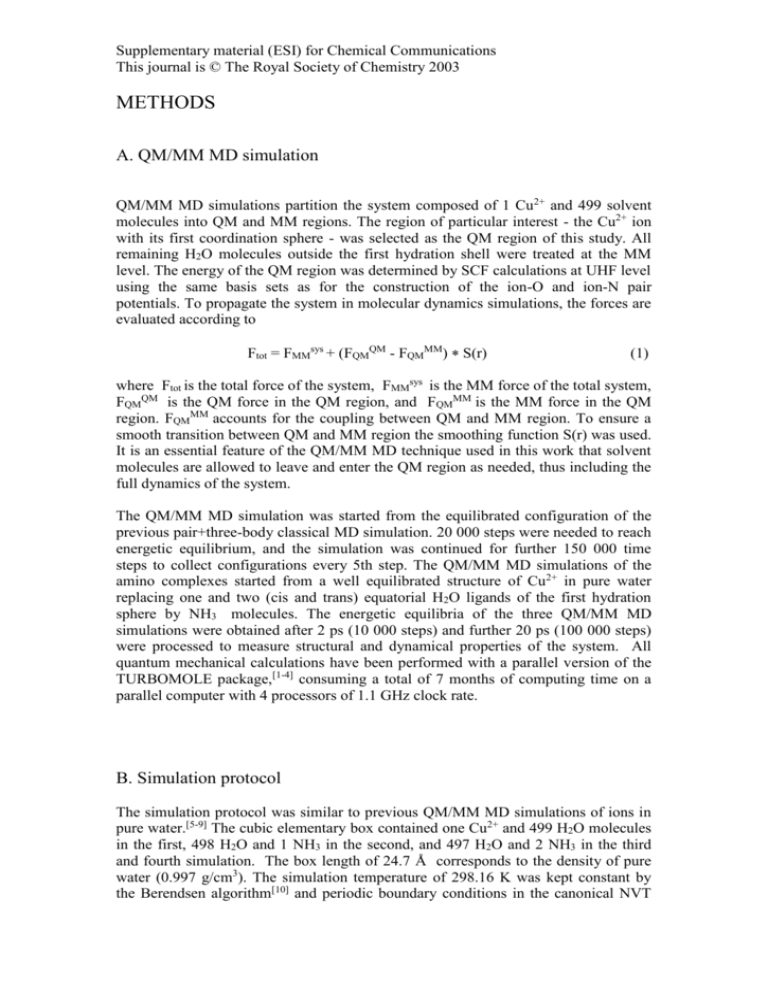
Supplementary material (ESI) for Chemical Communications This journal is © The Royal Society of Chemistry 2003 METHODS A. QM/MM MD simulation QM/MM MD simulations partition the system composed of 1 Cu2+ and 499 solvent molecules into QM and MM regions. The region of particular interest - the Cu2+ ion with its first coordination sphere - was selected as the QM region of this study. All remaining H2O molecules outside the first hydration shell were treated at the MM level. The energy of the QM region was determined by SCF calculations at UHF level using the same basis sets as for the construction of the ion-O and ion-N pair potentials. To propagate the system in molecular dynamics simulations, the forces are evaluated according to Ftot = FMMsys + (FQMQM - FQMMM) S(r) (1) where Ftot is the total force of the system, FMMsys is the MM force of the total system, FQMQM is the QM force in the QM region, and FQMMM is the MM force in the QM region. FQMMM accounts for the coupling between QM and MM region. To ensure a smooth transition between QM and MM region the smoothing function S(r) was used. It is an essential feature of the QM/MM MD technique used in this work that solvent molecules are allowed to leave and enter the QM region as needed, thus including the full dynamics of the system. The QM/MM MD simulation was started from the equilibrated configuration of the previous pair+three-body classical MD simulation. 20 000 steps were needed to reach energetic equilibrium, and the simulation was continued for further 150 000 time steps to collect configurations every 5th step. The QM/MM MD simulations of the amino complexes started from a well equilibrated structure of Cu2+ in pure water replacing one and two (cis and trans) equatorial H2O ligands of the first hydration sphere by NH3 molecules. The energetic equilibria of the three QM/MM MD simulations were obtained after 2 ps (10 000 steps) and further 20 ps (100 000 steps) were processed to measure structural and dynamical properties of the system. All quantum mechanical calculations have been performed with a parallel version of the TURBOMOLE package,[1-4] consuming a total of 7 months of computing time on a parallel computer with 4 processors of 1.1 GHz clock rate. B. Simulation protocol The simulation protocol was similar to previous QM/MM MD simulations of ions in pure water.[5-9] The cubic elementary box contained one Cu2+ and 499 H2O molecules in the first, 498 H2O and 1 NH3 in the second, and 497 H2O and 2 NH3 in the third and fourth simulation. The box length of 24.7 Å corresponds to the density of pure water (0.997 g/cm3). The simulation temperature of 298.16 K was kept constant by the Berendsen algorithm[10] and periodic boundary conditions in the canonical NVT Supplementary material (ESI) for Chemical Communications This journal is © The Royal Society of Chemistry 2003 ensemble were applied to the simulation box. The flexible BJH-CF2 model[11,12] proved to be suitable to describe water-water interactions[5-9] in QM/MM MD simulations of ions in aqueous solution. For ammonia ammonia interactions a flexible four site model was employed[13] and the waterammonia potential was newly constructed. The use of flexible models is required for reasons of compatibility between the MM region and the (fully flexible) QM region. Since these models allow for explicit hydrogen movements the time step was set to 0.2 fs. The cutoff was set to 12 Å except for O-HW, HW-HW, N-HA, HA-HA non Coulombic interactions where distances of 5.0 Å, 3.0 Å, 6.0 Å and 5.0 Å are sufficient. To account for long-range electrostatic interactions the reaction field technique[14] was applied and the Newtonian equations of motion were treated by a general predictor-corrector algorithm. Supplementary material (ESI) for Chemical Communications This journal is © The Royal Society of Chemistry 2003 References 1 R. Ahlrichs, M. Bär, M. Häser, H. Horn and C. Kölmel, Chem. Phys. Lett., 1989, 162, 165. 2 S. Brode, H. Horn, M. Ehrig, D. Moldrup, J. E. Rice and R. Ahlrichs, J. Comput. Chem., 1993, 14, 1142. 3 R. Ahlrichs and M. von Arnim, in Methods and Techniques in Computational Chemistry: METECC-95, edited by E. Clementi and G. Corongiu (STEF, Cagliari, 1995), Chap. 13, pp. 509-554. 4 M. von Arnim and R. Ahlrichs, J. Comput. Chem., 1998, 19, 1746. 5 Y. Inada, A. M. Mohammed, H. H. Loeffler and B. M. Rode, J. Phys. Chem. A, 2002, 106, 6783. 6 H. H. Loeffler and B. M. Rode, J. Chem. Phys., 2002, 117, 110. 7 J. I. Yagüe, A. M. Mohammed, H. Loeffler and B. M. Rode, J. Phys. Chem. A, 2001, 105, 7646. 8 C. F. Schwenk, H. H. Loeffler and B. M. Rode, J. Chem. Phys., 2001, 115, 10808. 9 A. Tongraar, K. R. Liedl and B. M. Rode, J. Phys. Chem. A, 1998, 102, 10340. 10 H. J. C. Berendsen, J. P. M. Postma, W. F. van Gunsteren, A. DiNola and J. R. Haak, J. Phys. Chem., 1984, 81, 3684. 11 F. H. Stillinger and A. Rahman, J. Chem. Phys., 1978, 68, 666. 12 P. Bopp, G. Janscó and K. Heinzinger, Chem. Phys. Lett., 1983, 98, 129. 13 S. V. Hannongbua, T. Ishida, E. Spohr and K. Heinzinger, Z. Naturforsch. A, 1988, 43, 572. 14 D. J. Adams, E. M. Adams and G. J. Hills, Mol. Phys., 1979, 38, 387.



